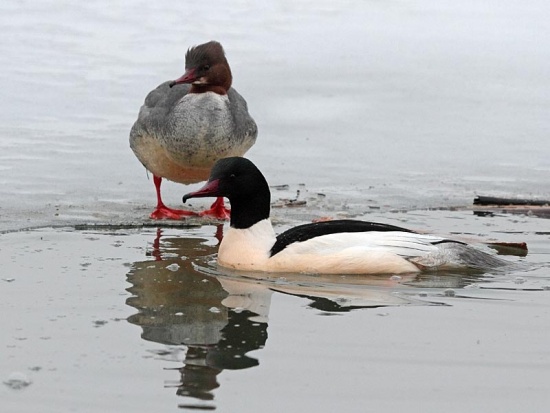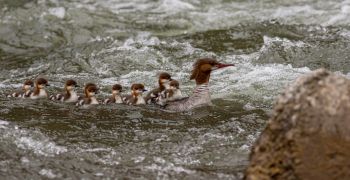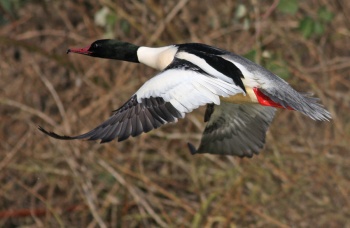Alternative name: Goosander
- Mergus merganser
Identification
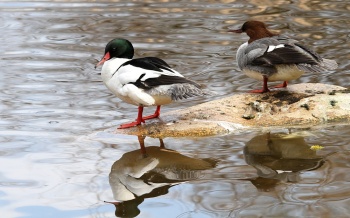
Photo © by eastwood
Vancouver, British Columbia, Canada, 30 April 2011
58-68 cm (23-27 in)
Adult Male
- Greenish-black head and upper neck
- White breast, flanks and belly, often tinged salmon-pink.
- Black back and upperwing coverts; scapulars white with a narrow black edge.
- Secondaries white; secondary coverts all-white giving a fully white inner wing (Goosander M. m. merganser) or with dark tips making a dark bar across the white (Common Merganser M. m. americanus).
- Eclipse plumage from June-July to October-November similar to adult female.
Adult Female
- Red-brown head meets pale breast in crisp line of division.
- Well-defined white chin.
- White breast and belly grading to grey flanks.
- Pale grey body plumage.
Juvenile
- Similar to adult female, but with white spot or line on lores, giving a 'striped' effect to the face.
Similar Species
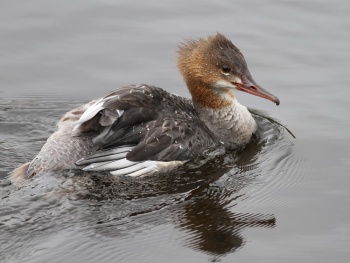
Photo © by IanF
Dumfries, Dumfries & Galloway, Scotland, 3 September 2011
Female may be confused with female Red-breasted Merganser, but shows a distinct division between head and chest. Crest is also less shaggy and the bill distinctly less slender than in female Red-breasted.
Distribution
Breeding
Europe
Breeds in Iceland and north and west Britain, throughout Scandinavia and across northern Europe from Poland eastwards. Breeding range slowly expanding west and south in Europe, reaching Germany and the Alps over the last 150 years, Scotland in 1871, northern England in 1941, Wales and Ireland in 1970, and a recent colonist in the Netherlands (where first bred in 1996), the Czech Republic, and northern Greece at Lake Prespa.
Asia
Breeds across northern Asia to northern China, Sakhalin and occasionally Hokkaido, with a separate population on the Tibetan Plateau.
North America
Breeds in southeast Alaska and western Canada across the forest zone of central Canada and east to Newfoundland. In the USA breeds in the north-east and around the Great Lakes, and in the west range extends south to northern California, Arizona and New Mexico.
Northern populations are migratory, most others resident or partial migrants, moving to coastal areas close to breeding site. In winter found in southern Britain and northern France east to Poland and in coastal Norway and Sweden. Small numbers also winter in Central Europe, the northern Mediterranean and the Black and Caspian Seas. In the Far East winters from Japan southwards and in North America winters over much of the USA except the north-central states and the Gulf Coast.
Many, if not most, males in the European population leave the females to care for their ducklings in midsummer and fly north to the Varangerfjord in northeast Norway for moulting, before returning in late autumn.
Vagrant to Greenland, the Faroes and Svalbard and south to Portugal and Spain, the Mediterranean islands, north Africa and Israel, also recorded on Bermuda.
Taxonomy
Race M. m. americanus has been treated as a separate species American Merganser (Mergus americanus) by the AOU until 1931, but this has not been recognised more recently by any of the main ornithological authorities[2].
Subspecies
There are three subspecies[1]:
- M. m. merganser (Goosander).
- M. m. orientalis (Asian Goosander).
- Afghanistan to Tibet and southern China; winters to India and southwestern China. Slightly larger and shorter-billed than M. m. merganser.
- M. m. americanus (Common Merganser).
- Breeds in North America southern and central Alaska east to eastern Canada, and south to northern California, Colorado, and the north central and northeastern United States; winters southern Alaska and Maritime Provinces (Canada) south to north central Mexico.
- It has deeper base to bill, lacking protruding wedge of maxillary feathering, and the male has dark bar across bases of median coverts.
Race M. m. comatus (Tibetan Goosander) restricted to the Tibetan Plateau in central Asia now merged with M. m. orientalis.
Habitat
Breeds along rivers and lakeshores in wooded areas, sometimes on moorland, on passage and in winter on large freshwaters, often reservoirs and gravel-pits, sometimes estuaries but rarely on the sea.
Behaviour
The diet includes fish, mussels, shrimps, and aquatic insects.
Vocalisation
References
- Clements, J. F., T. S. Schulenberg, M. J. Iliff, T. A. Fredericks, J. A. Gerbracht, D. Lepage, S. M. Billerman, B. L. Sullivan, and C. L. Wood. 2022. The eBird/Clements checklist of Birds of the World: v2022. Downloaded from https://www.birds.cornell.edu/clementschecklist/download/
- Lepage D. (2021) [Avibase - https://avibase.ca/407E2CA8 ]. Retrieved 14 June 2021
- Carboneras, C. & Kirwan, G.M. (2019). Goosander (Mergus merganser). In: del Hoyo, J., Elliott, A., Sargatal, J., Christie, D.A. & de Juana, E. (eds.). Handbook of the Birds of the World Alive. Lynx Edicions, Barcelona. (retrieved from https://www.hbw.com/node/52931 on 20 April 2019).
- Pearce, J., M. L. Mallory, and K. Metz (2015). Common Merganser (Mergus merganser), version 2.0. In The Birds of North America (A. F. Poole, Editor). Cornell Lab of Ornithology, Ithaca, NY, USA. https://doi.org/10.2173/bna.442
- Collins Bird Guide ISBN 0 00 219728
Recommended Citation
- BirdForum Opus contributors. (2024) Common Merganser. In: BirdForum, the forum for wild birds and birding. Retrieved 23 April 2024 from https://www.birdforum.net/opus/Common_Merganser
External Links
GSearch checked for 2020 platform.1




